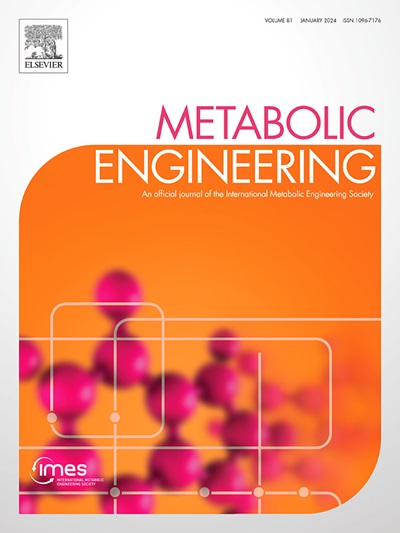大肠杆菌胞质和周质高效合成丹丹酸A的工程研究。
IF 6.8
1区 生物学
Q1 BIOTECHNOLOGY & APPLIED MICROBIOLOGY
引用次数: 0
摘要
植物多酚是一类具有营养和药用价值的天然植物产物,可由微生物细胞工厂替代生产。然而,微生物宿主体内的代谢串扰和酶不相容性限制了它们的合成。因此,我们开发了一种可持续驱动的生物技术工艺,利用细胞质周质组合工程来生产丹参酸a (SAA),这是一种从丹参根中提取的植物多酚。SAA具有强大的心血管和治疗效益,但其不断增长的需求受到有限的自然产量的限制。首先,我们通过鉴定高效的4-羟基苯基酸脱氢酶和4-羟基苯基酸羟化酶来优化人工SAA途径,然后提高羟化酶的催化性能。周质工程进一步提高了SAA的合成,同时减少了副产物的形成。此外,辅助因子工程被应用于确保周质和细胞质辅助因子的充足供应。该菌株的SAA产量可达37.26 g L-1,创下了工程微生物性能的新纪录。本文报道的策略可用于其他植物多酚及其天然产物的大规模生产。本文章由计算机程序翻译,如有差异,请以英文原文为准。
Engineering of Escherichia coli cytoplasm and periplasm for efficient synthesis of salvianic acid A
Plant polyphenols, a class of natural plant products with nutritional and medicinal value, can be alternatively produced by microbial cell factories. However, metabolic cross talk and enzyme incompatibility within the microbial host limits their synthesis. Therefore, we developed a sustainability-driven biotechnological process using cytoplasm periplasm combinatorial engineering to producing salvianic acid A (SAA), a plant polyphenol derived from the roots of Salvia miltiorrhiza. SAA possesses potent cardiovascular and therapeutic benefits, but its rising demand is constrained by limited natural yields. First, we optimized an artificial SAA pathway by identifying an efficient 4-hydroxyphenyllatic acid dehydrogenase and 4-hydroxyphenyllatic acid hydroxylase, followed by improving the catalytic performance of hydroxylase. Periplasm engineering further enhanced SAA synthesis while reducing by-product formation. Additionally, cofactor engineering was applied to ensure an adequate supply of both periplasmic and cytoplasmic cofactors. The resulting strain was capable of producing up to 37.26 g L−1 of SAA, a new record in engineered microbial performance. The strategy reported here can be used for the large-scale production of other plant polyphenols and natural products.
求助全文
通过发布文献求助,成功后即可免费获取论文全文。
去求助
来源期刊

Metabolic engineering
工程技术-生物工程与应用微生物
CiteScore
15.60
自引率
6.00%
发文量
140
审稿时长
44 days
期刊介绍:
Metabolic Engineering (MBE) is a journal that focuses on publishing original research papers on the directed modulation of metabolic pathways for metabolite overproduction or the enhancement of cellular properties. It welcomes papers that describe the engineering of native pathways and the synthesis of heterologous pathways to convert microorganisms into microbial cell factories. The journal covers experimental, computational, and modeling approaches for understanding metabolic pathways and manipulating them through genetic, media, or environmental means. Effective exploration of metabolic pathways necessitates the use of molecular biology and biochemistry methods, as well as engineering techniques for modeling and data analysis. MBE serves as a platform for interdisciplinary research in fields such as biochemistry, molecular biology, applied microbiology, cellular physiology, cellular nutrition in health and disease, and biochemical engineering. The journal publishes various types of papers, including original research papers and review papers. It is indexed and abstracted in databases such as Scopus, Embase, EMBiology, Current Contents - Life Sciences and Clinical Medicine, Science Citation Index, PubMed/Medline, CAS and Biotechnology Citation Index.
 求助内容:
求助内容: 应助结果提醒方式:
应助结果提醒方式:


